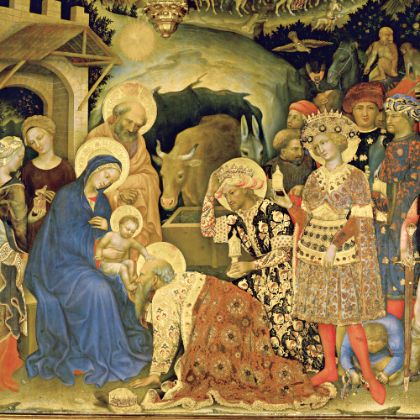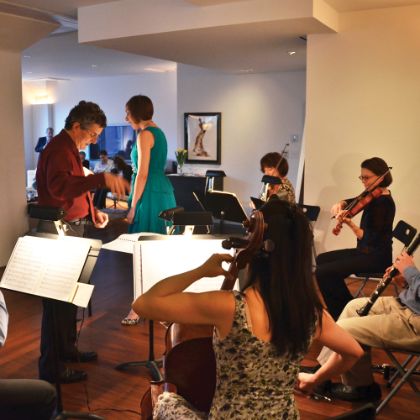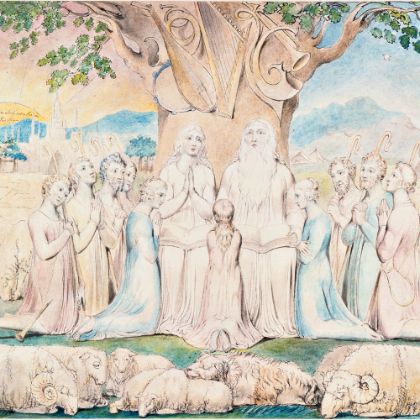Everything you always wanted to know about Baroque concertos (but were afraid to ask)
By David Hurwitz
When we think of a concerto, we usually mean a piece for a single solo instrument with orchestra, but this use of the term is, in fact, more recent than you might imagine. The word itself means “to strive together,” and like “sonata” can refer to just about any combination of forces, including voices. Indeed, vocal music is key in considering the concerto, because until very recently it was universally assumed that (a) the greatest instrument of all was the human voice, (b) all supposedly abstract instrumental music aspired to reach the same level of communicative specificity as music with words, and (c) the highest form of instrumental technique was that which came closest to imitating the technique and emotional expressivity of a great singer. Accordingly, the forms of instrumental music as they evolved in the Baroque period were modeled closely on two basic human activities: singing and dancing.
In addition to these very general parameters, composers took their bearings from where the music was destined to be performed, be it the church, theater, concert hall or aristocratic salon. Dance-type music was deemed appropriate only in secular settings — for obvious reasons — while music intended for liturgical use emphasized the more serious side of things, with solemn, slow movements and quicker ones that featured intricate counterpoint and other supposedly “learned” musical devices. Of course, in real life, composers often mixed the secular and liturgical. Popular works written for the church could be played in the concert hall, and as with all human institutions, the major religions have always understood the need to put on a good show.
Indeed, in the seventeenth and eighteenth centuries, when the death of a monarch or a major holiday (and they had many more of both than we do now) meant the closing of theaters and restrictions on other forms of public entertainment, the church was often the only place that the public could go to hear music performed, and the only place that musicians could find steady work. J.S. Bach famously complained in one of his few surviving letters that when “a healthy wind” blew through Leipzig he suffered serious financial harm, owing to a decline in the need for funeral music. Baroque composers wrote concertos not so much as a repertoire of works designed to be appreciated in formal concert settings, but as an integral aspect of people’s daily lives, as part of the natural rhythm of both the secular and liturgical calendars.
This, then, is the first important characteristic that should be considered in any discussion of Baroque concertos: whether they were deemed suitable for the church (to provide interludes between major portions of the service) or designed more for the “chamber” (or concerto room). Nowadays when we see works called “chamber concertos,” such as those by Vivaldi, we think of “chamber music”— that is, pieces for a small number of players. But the word “chamber” in a title from the Baroque period has little to do with the number of performers and more to do with the kind of music it most likely contains.
The rule of thumb is this: if a concerto (or any other instrumental work) composed in the Baroque period begins with a full-fledged slow movement, it probably belongs to the “church” category, whereas if it begins with quick music or features imitative elements (including dancing, storms, birds or images of the four seasons), then it’s a “chamber,” or secular, concerto. As the concerto developed in the early eighteenth century, these lines became increasingly blurred.
The next significant factor governing the evolution of the Baroque concerto concerns the number of solo instruments and how they are used. Here we meet the first major name in concerto history: Arcangelo Corelli (1653–1713). Corelli wrote only twelve concertos, and they were not published until 1714, a year after his death, but there have been few collections of pieces more widely admired and imitated. Designated as his Op. 6, Corelli wrote eight “church” concertos (concerti da chiesa) and four “chamber” concertos (concerti da camera), including his most famous piece, the so-called “Christmas Concerto” (No. 8 in the set). The “Christmas” aspect comes from the finale, a gentle pastoral similar in mood to the “Pastoral Symphony” found in Handel’s Messiah.
Although published posthumously, Corelli’s Op. 6 concertos were composed considerably earlier, and their final versions are thought to represent the end-result of a lengthy process of refinement through practical performance. This is one reason why the music still “works” so well today, and has withstood the test of time. In the late seventeenth and early eighteenth centuries, music publishing was still an industry in its relative infancy, a privilege reserved for the most important pieces, particularly if these consisted mostly of concert or secular music. The very fact that Corelli’s concertos were published and achieved wide international dissemination attests to their exceptional importance, both in their own time and afterwards.
All of these pieces fall into the category of concerto grosso, which simply means “big concerto.” As defined by Corelli with these works, a concerto grosso consists of a group of soloists — in this case, two violins and a cello — opposed by a larger orchestra of strings called the ripieno, which, not too surprisingly, means “everyone else.” Each group, both small and large, is accompanied by a permanently subordinate continuo consisting of harpsichord, lower strings and possibly a plucked instrument (a lute, theorbo, guitar or something similar).
What made Corelli’s work so important was, first, the amount of color and variety he was able to achieve through the interaction of the soloists with the full ensemble, and second, the sheer lyrical beauty of his melodies, which, of course, brought them closer to the vocal ideal.
The reasons for the concerto grosso dying out in the second half of the eighteenth century are complex and still not fully understood.
Indeed, although there are twice as many “church” works in Op. 6 as there are in the “chamber” style, Corelli was noted for his avoidance of strict counterpoint and for his emphasis on tunes accompanied simply. This practice naturally emphasized the key point of contrast in any true concerto — the opposition between the soloists and the full orchestra — and made Corelli’s concertos unusually clear in terms of expression, ensuring their popularity right through to the present day. They also initiated an explosion of concerto composition in Italy and abroad. Some of Corelli’s more interesting successors were:
Pietro Locatelli (1695–1764)
A student of Corelli, Locatelli’s Op. 3 concertos subtitled L’Arte del violino (“The Art of the Violin”), are landmarks in the history of violin technique. The twelve concertos contain twenty-four capriccios, free-form movements for solo violin that exploit the instrument’s virtuoso potential.
Giuseppe Tartini (1692–1770)
Famous as both a composer and a pedagogue, Tartini’s best-known composition is the “Devil’s Trill” violin sonata. However, he also composed more than one hundred thirty violin concertos, and his treatise on violin playing heavily influenced Leopold Mozart when he needed material for the first edition of his violin school, which appeared in the 1750s.
Francesco Geminiani (1687–1762)
Another student of Corelli, Geminiani moved to England in 1714 and composed three sets of concerti grossi (Op. 2, Op. 3 and Op. 7) that include the viola in the solo group, effectively turning them into concertos for string quartet and orchestra. As a violinist, Geminiani was nicknamed “the madman” for the passionate intensity of his playing and his freedom of tempo. He also wrote a very important violin treatise (1751) that stands with those of Tartini and Mozart among the most important pedagogical works of the period.
Perhaps the most important of the many works crafted in the image of Corelli was another set of a dozen concertos also published as “Opus 6,” in this case by Handel in self-conscious homage to his illustrious predecessor. Composed in 1739–40, these “Twelve Grand Concertos,” as they were called, are grand in every sense of the term, full of delightful melodic invention, formal ingenuity and colorful exploitation of string sonorities. Nevertheless, they represent the end of the road for this particular type of concerto.
The reasons for the concerto grosso dying out in the second half of the eighteenth century are complex and still not fully understood. Some of it had to do with changing tastes and the rise of the new, continuo-free style of instrumental writing in the Gallant and later the Classical periods, whose seeds had in fact been planted by Corelli. Concertos for multiple soloists naturally favor polyphony, the use of counterpoint so that all of the soloists can engage in simultaneous dialogue among themselves and in opposition to the full orchestra. Reduce the amount of counterpoint, and there’s not much use in having more than a single soloist.
This is exactly what composers such as Antonio Vivaldi (1678–1741) did. In the first decades of the eighteenth century, Vivaldi wrote more than five hundred concertos. Of these, the majority (around three hundred fifty) are for a single soloist, mostly violin. Curiously, the instrument that Vivaldi favored most after the violin was the bassoon, then — as now — a relatively unlikely candidate for solo treatment. Vivaldi was in charge of an orchestra of orphan girls in Venice, a group that achieved considerable acclaim for its collective virtuosity. He also composed concertos for the heavily Italianate court musicians resident in the East German city of Dresden.
The type of concerto Vivaldi pioneered was quite different from the concerto grosso, at least in theory, though as always in these cases, the practice of a form varied widely from one composer to another. Most of Vivaldi’s concertos, including the set of four that make up The Four Seasons (actually part of a larger set of twelve comprising his Op. 8), contain only three movements, in the order fast–slow–fast. Counterpoint is minimized; melody, instrumental virtuosity and color maximized. At times the invention turns formulaic (if you wrote five hundred concertos you’d come up with a few tried-and-true shortcuts yourself), and there’s some truth to the quip that Vivaldi wrote the same concerto five hundred times, but the more you get to know the individual pieces the more complex and well-crafted they appear. Bach, for example, was fascinated by them, and arranged a number for solo keyboard. In one famous case, he took a concerto for four violins from Vivaldi’s Op. 3 set and turned it into a clangorous romp for four harpsichords and string orchestra.
The reduction of the number of movements to three signaled a different approach to form, one that brought the music even closer to its roots in the Baroque opera aria (at least in the quick movements). Known as “ritornello” form, the concept is simple: the orchestra states a theme, the solo enters with its first episode, and the orchestra breaks in with bits of the original theme (or ritornello) in various related keys between each solo, finishing with a complete restatement of the opening in the original key. But instead of a singer the new concerto form used a solo instrument, which freed the composer from the need to convey actual words.
Composers in the Baroque period were expected to limit the music of an aria to a single emotion, or ‘affect’: love, sorrow, vengeance, heroism, or terror, as dictated by the text.
This had significant consequences. Most aria texts are short and get repeated about a million times, leaving the singer a chance to ornament the vocal line with impressive coloratura embellishments. Also, composers in the Baroque period were expected to limit the music of an aria to a single emotion, or “affect”: love, sorrow, vengeance, heroism or terror, as dictated by the text. None of these limitations apply to purely instrumental music, at least not to the same degree, and composers were quick to understand that they could now create longer movements and fill them with music of greater variety. This compensated to some extent for the lack of expressive immediacy and specificity inherent in music with words.
J.S. Bach seized the opportunity with particular relish. His largest concertos, including several in the well-known “Brandenburg” set and his intensely dramatic Harpsichord Concerto in D minor, last twice as long as a typical concerto by Vivaldi. But if a composer knows what he is doing, he will justify a longer running time by writing especially interesting music, and that is exactly what Bach did in his best concertos. Unfortunately, there aren’t many. Most of Bach’s orchestral music is lost, and many of the surviving concertos have only come down to us in the form of arrangements. His keyboard concertos, for example, were mostly written for the violin originally. Aside from those we only have the six Brandenburg Concertos, each for a different combination of instruments, the three violin concertos (one of these is for two violins) and the Triple Concerto. What Bach’s concertos lack in number, however, is more than made up for in terms of musical importance. In transcribing his works for the harpsichord, for instance, Bach invented one of the most important of all types of concerto: that for solo keyboard.
It’s always dangerous in the history of music to say that anyone did something first, but Bach’s harpsichord concertos (including Brandenburg No. 5) evidently really are the first examples of their kind. His son, Carl Philip Emanuel, became the most authoritative keyboard composer and pedagogue of the eighteenth century. He wrote some five dozen keyboard concertos, many of them superbly enjoyable and all but unknown today (although a very fine complete edition is in progress courtesy of BIS Records). These works, often intensely emotional and dramatic in tone, represent the connecting link between the Baroque concerto and the great Classical works of Mozart and Beethoven.
The niftiest thing about a harpsichord (or piano) is that, harmonically speaking, it can do everything the orchestra can. It is not limited merely to playing the melody, and can challenge the full ensemble in ways that a melody instrument, such as a flute or violin, simply cannot. The result is the opportunity for a more dramatic, confrontational relationship between the soloist and the orchestra. This is precisely the aspect of concerto form that inspired composers of the Classical period, and it explains why the instrument of choice for the greatest concertos of that era, such as those by Mozart and Beethoven, was not the violin, but the piano. Still, no matter what instrument takes the solo role, all concertos, without exception, embody the basic, even primal opposition of the one versus the many, and they remain the Baroque period’s prime contribution to the evolution of orchestral music.

Photos: Erich Lessing, Scala, The Granger Collection, NY, Lebrecht Music & Arts
-

From Christemasse to Carole
The birth of Christmas in medieval England
Read More
By David Vernier -

The Next (Not-So-)Big Thing
New chamber orchestras are popping up all over America.
Read More
By Colin Eatock -

A Father's Lament
Finding solace in the sound of authentic sorrow
Read More
By Rev. Jake Bohstedt Morrill